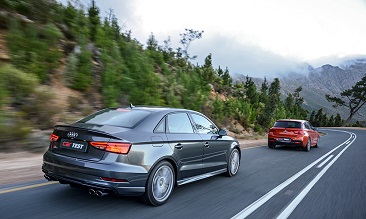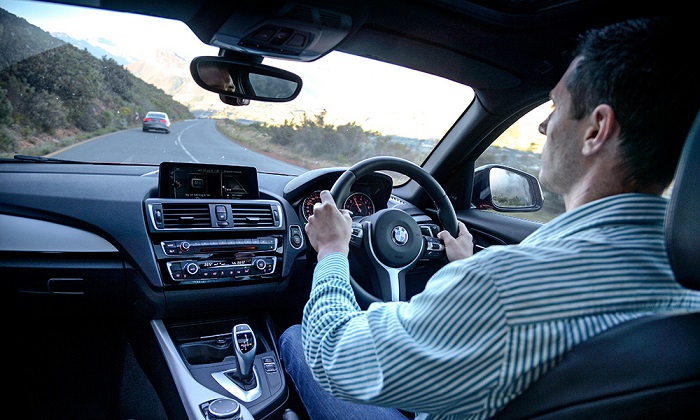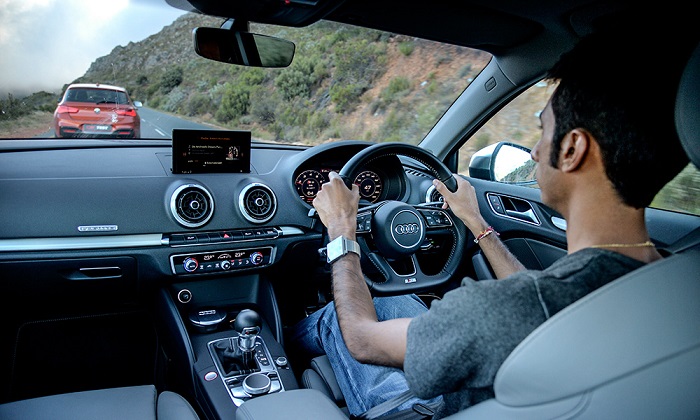 Yes, the Audi RS3 with its 294 kW, five-cylinder engine may occupy the top of the range, but this S3 Sedan with its 228 kW/400 N.m four-cylinder engine claims serious artillery. With the recent facelift, these figures have been increased by 22 kW and 20 N.m.
Yes, the Audi RS3 with its 294 kW, five-cylinder engine may occupy the top of the range, but this S3 Sedan with its 228 kW/400 N.m four-cylinder engine claims serious artillery. With the recent facelift, these figures have been increased by 22 kW and 20 N.m.
The same applies to BMW’s 1 and 2 Series models. Sure, the M2’s impressive ability to cover ground quickly has been well documented, but the latest incarnation of the model that slots below the halo M also boasts big numbers. The uprated M140i features the newest version of BMW’s acclaimed inline six-cylinder engine and now, on paper, offers equivalent figures to that of the legendary BMW 1M, with a rounded 250 kW and 500 N.m. That’s 10 kW and 50 N.m up on the M135i.
And all of that makes for a rather interesting comparison. The BMW betters its Ingolstadt rival in output figures, but the Audi counters with a lower price, all-wheel drive and a bigger boot in this notchback shape.
Design outside and in
Offering four doors, both these cars can be used on a daily basis, but rear passenger space is slightly limited and adults 1,80 metres and taller will want for more leg- and headroom. This is especially the case if front-seat passengers enjoy that little extra legroom and push their seats back.
Both cars boast subtly sporty exterior touches, with selective accents on the lower bumpers, the Audi with its large intakes with vertical bars and the BMW with its grey C-shaped inserts. Give the Audi a quick glance and you may miss its performance credentials. Look at the tail pipes, though, and there’ll be no doubt. Quad exhausts lurk under the rear bumper and betray the kilowatts that lie beneath the bonnet. The BMW, on the other hand, plays its cards further from its chest. The eye-catching Valencia Orange paint job makes no bones about the car’s tyre-shredding intentions, as do the dark, double-spoke wheels.
Climb inside and it is the Audi that impresses most with its cabin quality. There is no question that this automotive brand sets the standard in terms of the selection, quality and application of material trimmings, as well as overall execution and design. Every button is a joy to use and you can feel the quality imbued in every tactile surface. The BMW is not far behind, but the cabin doesn’t quite offer the Audi’s attention to detail and one part in particular, the plastic trimming on the spokes of the M steering wheel, feels cheap.
Both cars offer full infotainment systems with all the main audio connections. Satellite navigation is optional on the Audi, but it does offer spec such as a knee airbag and a 60:40-split rear seat configuration as standard. The latter is optional on the BMW (R3 600). The Audi Virtual Cockpit (R7 250) gives the instrument cluster a distinctly high-end feel, as does the MMI navigation with MMI touch (R24 000). The options lists on both are vast, and buyers are advised to tread carefully in selecting equipment, or their base prices will quickly inflate.

On the road
Once on our test strip, equipped as it is with quattro all-wheel-drive technology, it was no surprise the S3 hit 100 km/h quicker than the more powerful BMW. With launch control activated, right foot full on the throttle, left on the brake and the rev needle hovering at 4 000 r/min, the S3 jumped forward as soon as we sidestepped the brake. Displaying little in the way of wheelspin, it hit 100 km/h in a brisk 4,90 seconds. This is a markedly better time than the previous six-speed auto-equipped model’s time of 5,38 seconds.
Even with launch control, it was trickier to get the rear-wheel-drive M140i off the line smoothly and efficiently, but the BMW still posted a very quick 5,30 seconds. With its more potent 3,0-litre, turbocharged six-cylinder engine, it was during in-gear acceleration where the BMW triumphed.
That said, considering they’re a mere 4 kg apart, the Audi’s engine punches above its weight. The Audi’s brakes and tyres also stood up well to the repetitive braking tests, averaging 2,82 seconds. The BMW managed an average of 2,98 seconds. On our set fuel route, both cars sipped similar quantities of petrol, with the S3 using 9,6 L/100 km versus the BMW’s 9,0. Not that most owners will drive this conservatively. Given the nature and abilities of each vehicle, more enthusiastic driving is likely, which will push up those figures considerably.

In the bends
And that’s why, during our two-week test period, the CAR team took these two to one of our favourite mountain passes. On an early weekday morning, with most of South Africa still in bed, we descended on a well-known ribbon of asphalt, a road that offers two hairpins, a number of straights, as well as some faster, sweeping corners. Here the Audi felt surefooted and, with its all-wheel-drive system to bank on, it quickly had us trusting completely in its superior levels of grip. Rather than one particular axle trying to assert its dominance, the entire car moves round when changing direction at close to the limit. It feels very neutral. Drive it really hard and the S3 still understeers, but far less so than previous incarnations. In dynamic mode, a deeper burble reverberates from the exhaust system.
Still, the Audi couldn’t leave the chasing Bavarian hatch behind. At the wheel of the BMW, you immediately feel better positioned thanks to a driver’s seat that adjusts lower to the floor than the Audi’s. Our test unit came fitted with BMW’s Adaptive M suspension (R9 000) but, in terms of daily driving and handling, we didn’t feel that the BMW benefitted greatly from having this installed. Audi’s optional Magnetic Ride (R13 640) wasn’t fitted to our car, yet, overall, we found the S3’s ride quality slightly more polished than the BMW’s.
From the moment you pull away, it feels like the M140i should have the beating of its rival. With Sport+ mode selected, allowing for less electronic safety-net intervention, there’s instantly more fun and enjoyment to be had from behind the wheel. You definitely need to be more alert when driving the M140i, though; forget that you are driving a rear-wheel-drive car and the BMW will remind you the instant you apply the throttle too early or aggressively. Not equipped with a limited-slip differential, the M140i might spin the rear inside wheel in tight corners. Fortunately, these situations are few and far between.
The BMW also offers a raspy sound from the darkened exhaust pipes, one that you can easily hear when chasing it. It was a sound we heard a lot of as, in real terms, the BMW isn’t any quicker up the mountain than the S3 and the Audi stuck behind it, only losing ground when there was a long enough straight for the M140i to really stretch its legs.
We added a layer of testing to this comparison by taking both cars to Killarney Raceway for a track test (watch the video here). Under Deon Joubert’s expert guidance, the BMW crossed the line in 1:27,80 and the Audi in 1:29,30. Although cornering speeds were near identical, as we experienced on the road, it was on the straights at higher velocities that the BMW was able to pull ahead of the Audi.
This email address is being protected from spambots. You need JavaScript enabled to view it.
